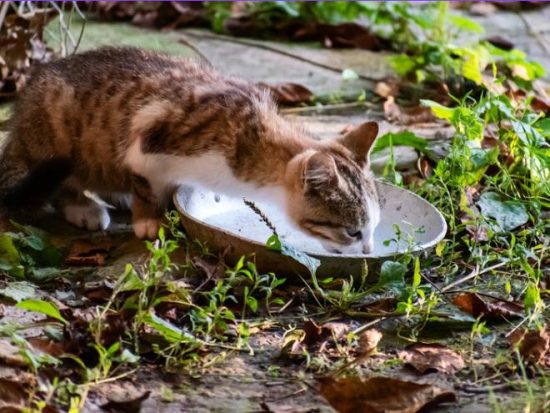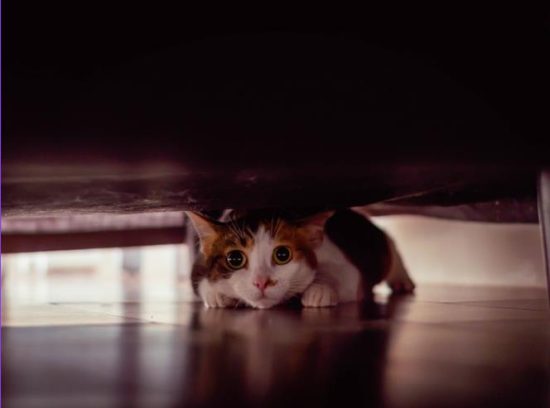How to Keep Cats Away from Your Property – Easy Tips
How to keep cats away: Effective solutions to humanely deter unwanted cats from entering your property using sound, smell, and visual deterrents.

Did you know that a single cat can leave up to 1,000 scent marks per day to establish its territory? This startling statistic highlights the persistent and determined nature of felines when it comes to claiming outdoor spaces as their own. Whether you’re dealing with stray cats, neighborhood felines, or even your own beloved pet, keeping them off your property can be a constant challenge. However, this comprehensive article explores a variety of effective and humane solutions that can help you reclaim your outdoor spaces.
From understanding the reasons cats may be drawn to your yard to implementing physical and sensory deterrents, this guide provides a step-by-step approach to keeping cats away from your home and garden. Wondering how to keep cats away from your property? , the tips covered in this article can help you protect your property from cats.
Understanding the Reasons for Unwanted Cats
The first step in effectively deterring cats from your property is to understand why they are drawn to your yard in the first place. According to the factual data, the primary reasons include the availability of food sources, the presence of hiding spots, and the cats’ natural territorial marking behavior. Identifying and addressing these attractants can make your property less appealing to unwanted feline visitors.
Availability of Food Sources

Cats are naturally curious and opportunistic animals, and the presence of readily available food sources can be a major factor in attracting them to your yard. This could include outdoor pet food, bird feeders, or even unsecured trash cans. Removing these food attractants can make your property less inviting for cats looking to satisfy their hunger.
Presence of Hiding Spots
Cats also seek out warm, sheltered areas where they can hide and feel secure. This could be under decks, in crawl spaces, or within dense vegetation. The factual data suggests that blocking access to these potential hiding spots can discourage cats from taking up residence in your yard.
Territorial Marking Behavior
Additionally, cats are naturally inclined to mark their territory through scent and visual cues. This can include leaving their scent on various surfaces or scratching objects to claim an area as their own. Understanding and addressing this territorial behavior can help deter cats from perceiving your property as a valid part of their domain.
By identifying and addressing these primary reasons for unwanted cat activity, you can develop a comprehensive strategy to make your property less appealing to feline visitors and reclaim your outdoor space.
Removing Food Attractants
One of the most effective ways to deter cats from your property is to remove any readily available food sources. The factual data recommends securing trash cans, keeping pet food indoors, and minimizing bird feeders, as these can all attract cats to your yard. By eliminating these food attractants, you can make your property less appealing to cats and discourage them from visiting. This simple yet important step lays the foundation for implementing other deterrent methods discussed in the article.
Securing Trash Cans

Ensuring your trash cans are securely closed and inaccessible to cats is crucial. Invest in cans with tight-fitting lids or consider using bungee cords or weights to keep the lids secure. This will prevent cats from scavenging for food scraps and discourage them from lingering in your yard.
Keeping Pet Food Indoors
If you have outdoor pets, be sure to keep their food and water bowls inside your home. Leaving pet food and water accessible outdoors can draw cats to your property, enticing them to stay and potentially interact with your pets. By keeping all pet-related resources indoors, you can eliminate this potential food source for unwanted feline visitors.
Minimizing Bird Feeders
While bird feeders can provide entertainment and enjoyment, they can also attract cats to your yard. If you choose to maintain bird feeders, consider placing them in a location that is less accessible to cats, such as high up on a pole or near your home’s entrance. Alternatively, you can opt for feeders with weight-sensitive perches that close off access when a heavier animal, like a cat, attempts to use them.
How to Keep Cats Away from Your Property?

Cats are naturally drawn to warm, dark spaces where they can hide from potential threats. By blocking access to these hiding spots, such as under decks or in crawl spaces, you can effectively deter cats from your property. One effective solution is to install chicken wire or lattice in these areas, making them less appealing to feline visitors.
Using Chicken Wire or Lattice
Covering potential hiding spots with chicken wire or lattice can create a physical barrier that discourages cats from entering. These materials make the spaces less comfortable and secure, encouraging cats to seek alternative locations. When installing these deterrents, be sure to secure them properly to prevent cats from finding gaps or weaknesses to exploit.
Checking for Trapped Animals Before Sealing
Before sealing off any access points or hiding spots, it’s crucial to thoroughly inspect the area for any trapped animals. Cats, as well as other small wildlife, may have taken up residence in these spaces, and it’s important to ensure their safety before permanently blocking the entrances. Take the time to carefully check for any signs of occupancy and make appropriate accommodations if you discover an animal in need of assistance.
Utilizing Scent Repellents
Cats have a highly developed sense of smell, and certain scents can effectively deter them from your property. The factual data recommends using commercial repellent sprays, as well as natural scents like citrus, coffee, and vinegar, to keep cats away from your home and yard.
There are a variety of commercial repellent sprays available on the market that are designed to keep cats at bay. These products often contain active ingredients like essential oils or synthetic compounds that cats find unpleasant, discouraging them from entering the treated areas. When used as directed, these sprays can be an effective way to repel cats from your property.
Natural Scents like Citrus, Coffee, and Vinegar
In addition to commercial sprays, you can also use natural scents to deter cats from your yard. Citrus fruits, such as oranges and lemons, and strong-smelling beverages like coffee, can be effective in keeping cats away. Vinegar, with its pungent aroma, is another natural deterrent that can be applied around the perimeter of your property.
Essential Oils and Plant-Based Repellents
Essential oils and plant-based repellents, such as lavender, rosemary, and rue, can also be effective in keeping cats away. These natural scents can be used in various ways, from diffusing them in the air to applying them directly to areas where cats are known to frequent. You can discourage cats from entering your yard by creating an unpleasant olfactory environment.
Planting Cat-Repelling Vegetation

In addition to scent-based deterrents, strategically planting certain aromatic herbs and vegetation can help keep cats away from your property. The factual data suggests that plants like rosemary, rue, and lavender are known to have a strong scent that cats find unpleasant, making them an effective natural barrier against feline visitors.
Rosemary, rue, and lavender are all examples of aromatic herbs that can be used to create a natural cat-repelling perimeter around your yard. Cats dislike the pungent scents of these plants, deterring them from venturing into areas where they are planted. By strategically placing these fragrant herbs along the edges of your property or in problem areas, you can create an effective, eco-friendly barrier to keep unwanted felines at bay.
Creating Uncomfortable Surfaces
Cats prefer soft, comfortable surfaces for lounging and digging, so making these areas unpleasant can effectively deter them from your property. The factual data suggests several methods to achieve this, all of which can help you regain control of your outdoor spaces without harming the felines.
One simple solution is to place plastic carpet runners with spikes on the ground in problem areas. The runners’ sharp, uncomfortable texture will discourage cats from walking or lounging on the treated surfaces, as their paws will find the experience unpleasant. Another option is installing CatScat mats, which feature flexible plastic spikes that flex underfoot but remain upright when not used. These mats create an uncomfortable surface that cats will avoid, making them an effective deterrent for keeping unwanted felines out of your yard.
The factual data suggests using sharp mulch or rocks in problem areas for a more natural approach. The abrasive texture of these materials can make the ground unpleasant for cats to walk on, discouraging them from entering your property and digging in your garden.
Implementing Ultrasonic Deterrents
Ultrasonic animal repellers are devices that emit high-frequency sounds that are inaudible to humans but can startle and deter cats and other wildlife. The factual data suggests that these devices can effectively keep cats away from your property, particularly when positioned around the perimeter or in high-traffic areas.
When selecting ultrasonic deterrents, choosing models specifically designed for outdoor use is important. These devices are typically weather-resistant and can withstand the elements, ensuring their effectiveness even in harsh weather conditions. Look for units that are weatherproof, UV-resistant, and have a long battery life or can be powered by a renewable energy source like solar panels.
To maximize the effectiveness of ultrasonic deterrents, it’s crucial to position them strategically around your property. Place the devices along the perimeter of your yard, near entry points, and in high-traffic areas where cats are most likely to roam. Ensure that the devices have a clear line of sight and are not obstructed by obstacles that could interfere with the sound waves. Regularly monitoring the devices and adjusting their placement as needed can help maintain their deterrent capabilities.
Installing Motion-Activated Sprinklers

Motion-activated sprinklers are another effective deterrent recommended to keep cats away from your property. These devices are triggered by motion sensors and release a burst of water when an animal enters the detection area. The startling effect can discourage cats from approaching your yard, as they generally dislike getting wet.
To maximize the effectiveness of motion-activated sprinklers, the factual data suggests strategically placing them around entry points and high-traffic areas on your property. By targeting these key locations, you can create a protective barrier that interrupts the cats’ natural pathways and discourages them from entering your space. While motion-activated sprinklers can be a reliable deterrent, the factual data also notes that they may not be as effective during colder months when the water in the hoses could freeze. It’s essential to consider the seasonal limitations of this method and be prepared to adjust your strategy or supplement it with other deterrents during the winter season to maintain a cat-free environment.
Exploring Trap-Neuter-Return Programs
In some cases, the most effective long-term solution for managing feral or stray cat populations in your neighborhood may be through a trap-neuter-return (TNR) program. The factual data suggests that collaborating with local animal welfare organizations can help implement this humane approach, which involves trapping, neutering, and then returning the cats to their habitat. This can help reduce the overall cat population and discourage new cats from taking up residence in your yard.
Collaborating with Local Animal Welfare Organizations
By working with local animal welfare organizations, you can tap into their expertise and resources to set up a successful TNR program in your area. These organizations can provide guidance on proper trapping techniques, access to low-cost or free spay/neuter services, and assistance with the return of the cats to their original habitat. Establishing a partnership with these groups can ensure a comprehensive and effective approach to managing the feral cat population in your neighborhood.
In addition to implementing a TNR program, the factual data suggests that providing alternative resources, such as food and shelter, in designated areas can help direct the cats away from your property. By creating designated feeding stations and shelters in approved locations, you can encourage the cats to congregate in those areas, rather than your yard. This strategy can complement the TNR approach and further discourage the cats from taking up residence on your property.
FAQs on keeping cats away from your property
How do you keep cats permanently away?
To keep cats permanently away from your property, a combination of strategies is recommended, including removing food attractants, blocking access to hiding spots, using scent repellents, planting cat-repelling vegetation, creating uncomfortable surfaces, and installing physical barriers like cat-proof fencing.
How do I keep my neighbor’s cat out of my yard?
To keep your neighbor’s cat out of your yard, you can try a variety of humane deterrents such as using commercial repellent sprays, applying natural scents like citrus or vinegar, installing ultrasonic animal repellers, and implementing motion-activated sprinklers. Collaborating with your neighbor to address the issue may also be beneficial.
How do I stop unwanted cats from coming to my property?
To stop unwanted cats from coming to your property, you can focus on removing food sources, blocking access to hiding spots, using scent-based deterrents, and creating physical barriers like cat-proof fencing. Exploring trap-neuter-return programs in your area can also help manage feral or stray cat populations in the long run.
What smell do cats hate?
Cats have a strong sense of smell and are known to dislike certain scents, including citrus, coffee, vinegar, essential oils like lavender and rosemary, and plant-based repellents such as rue and lavender. These scents can be used as effective deterrents to keep cats away from your property.
What is the best cat scarer?
Some of the most effective cat scarers include ultrasonic animal repellers, motion-activated sprinklers, and physical deterrents like cat-proof fencing or surfaces with spikes or sharp mulch. The best approach often involves using a combination of these methods to create a less appealing environment for cats.







